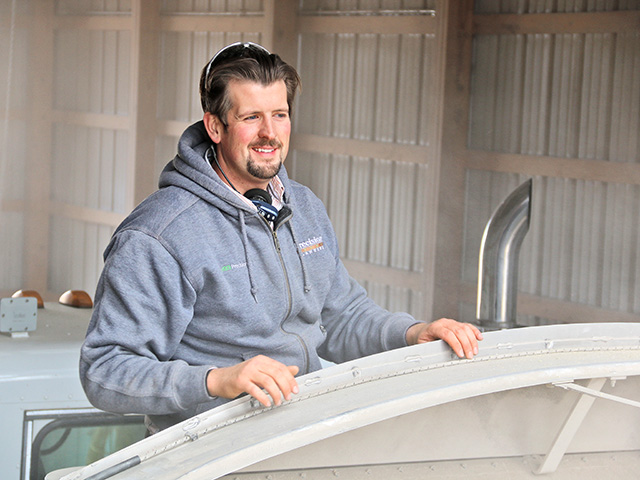This yearlong endeavor looks at how four farmers are evaluating technology and agronomic information that can boost the productivity of their operations.

Turning lemons into lemonade is an apt way to describe how Grant Strom managed the latter part of his 2015 season.
First, his V10 corn fungicide application was delayed to tassel stage when rains held up his soybean herbicide application. Those plans changed again when Northern corn leaf blight hit two fields early. Strom stopped the blight in its tracks with an aerial fungicide application at V12.
"Given the heavy disease pressure, we used a high rate of Headline Amp, and it did its job as needed until nature could take over," Strom says.
Thanks to a weather change, the disease backed off and didn’t invade other fields, and his fall–back fungicide application strategy resumed. A single application at VT, combined with planting corn hybrids with strong disease resistance and plant health, has worked well in the past. But it was a warning from BASF Innovation Specialist David Phelps that made the biggest difference for Strom’s corn.
"Several of us cover multiple states and share information on problem hybrids and diseases," Phelps notes. "I learned that Northern corn leaf blight was moving east. A couple of varieties with good ratings were proving susceptible, perhaps due to race shifts in the Northern blight. I let Grant know, and he scouted fields planted to those hybrids early."
Strom had seen the effects of Northern corn leaf blight before and recognized the indicators. He called in Phelps and Adam Dexter, an agronomist with West Central FS. They confirmed the disease and recommended immediate treatment. Phelps notes that, left untreated for two weeks before tassel, corn yield losses could have hit 50 to 60 bushels per acre.
The blight bad news followed by effective treatment good news is an ongoing theme for Strom. For instance, delayed soybean planting that initially threatened yields proved to be good news when sudden death syndrome struck mature soybeans in the area and left his alone. However, there was some bad news. Heavy rains in June prevented a planned post–herbicide application with residual on 2,000 acres of soybeans.
"We had just started on the beans when the rain began, and we didn’t turn a wheel on the sprayer for three weeks," Strom recalls. "By the time we could get in fields, the soybeans were too far along for residual over the top. Our preplant residual held well, but even fields that looked clean in early August had waterhemp popping up later. I can’t imagine how the fields would have been without the preplant."
The good news is Strom already has a plan to deal with weed issues in 2016. He will use BASF Zidua herbicide as part of his weed–control program for Palmer pigweed and waterhemp.
"We’ll use a lot of it on corn next year and as a preemerge application for residual control on soybeans," Strom notes. He also expects to use more Status (dicamba) in 2016. "I’ve been avoiding some herbicides due to cost, but next year, I’ll use the best products available pre– and post–, and a third application where needed," he says.
June rains also interfered with Strom’s plans for a split sidedress application of nitrogen. He purchased Y drops for a second sidedress trip in corn to supplement a preplant application and a first sidedress application at V3 and V4. Playing catch–up on soybean weed control forced a change in plans. Instead of the Y drops and his highboy, Strom used an aerial application.
"It cost us an extra $5 to $7 an acre and sacrificed placement accuracy, but we got it on when needed," he says. "The late pass is paying huge dividends. I was up in a helicopter in late August and could see a dramatic difference in our fields versus fields where different strategies had been followed."
The 2015 weather patterns that caused so many problems for Strom have reemphasized the importance of water management. "We had way too much early and not enough later," he says. "Proper drainage pays huge dividends, as does planting dates and nitrogen management. We will hope this year was an anomaly with rains, but. …"